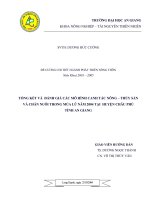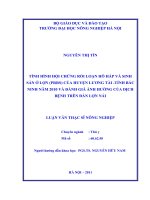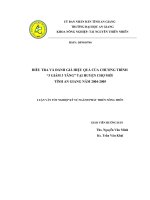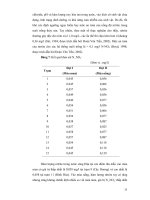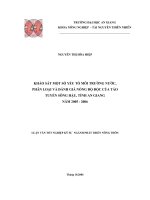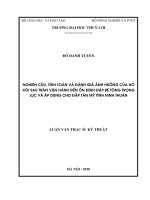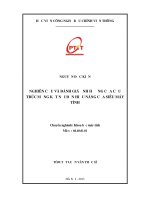Biểu hiện, tinh sạch và đánh giá tính chất của lumbrokinase ở pichia pastoris
Bạn đang xem bản rút gọn của tài liệu. Xem và tải ngay bản đầy đủ của tài liệu tại đây (237.84 KB, 11 trang )
Biểu hiện, tinh sạch và đánh giá tính chất của
lumbrokinase ở Pichia pastoris
Vũ Thị Bích Ngọc
Trường Đại học Khoa học Tự nhiên
Luận văn ThS Chuyên ngành: Sinh học thực nghiệm; Mã số
Người hướng dẫn: TS. Quyền Đình Thi; PGS. TS. Trịnh Hồng Thái
Năm bảo vệ: 2014
Keywords. Sinh học; Sinh học thực nghiệm; Lumbrokinase; Pichia pastoris.
Content
MỞ ĐẦU
Bê ̣nh tim ma ̣ch là mô ̣t trong những nguyên nhân gây t ử vong cao nhấ t trên toàn th ế
giới. Theo tổ chức Y tế thế giới (WHO), hàng năm có khoảng trên 17 triệu người chết vì
bệnh tim mạch, dự tính lên tới 23,3 triệu người vào năm 2030. Trên 80% các ca tử vong
xảy ra ở các nước có thu nhập thấp và trung bình, điển hình là các nước đang phát triển tại
vùng Nam Á và Đông Nam Á, nơi bệnh tim mạch đang gia tăng cùng với tốc độ công
nghiệp hóa, đô thị hóa và những thay đổi trong lối sống [64]. Tại Việt Nam, theo thống kê
của Viện tim mạch, tỷ lệ người dân mắc các bệnh tim mạch và đột quỵ khoảng 16% dân
số.
Có nhiều nguyên nhân dẫn tới rối loạn tim mạch và mạch máu não như: chứng tràn
máu não, tăng huyết áp, xơ cứng động mạch,….[34]. Trong tổng số các bệnh nhân bị tai
biến mạch máu não thì có đến 24% tử vong, 50% sống nhưng bị các di chứng nặng hoặc
nhẹ, chỉ có 26% số bệnh nhân sống và làm việc bình thường. Nguyên nhân chủ yếu là do
xuất hiện cục máu đông gây tắc mạch và cản trở lưu thông máu. Do đó, việc làm tan cục
máu đông đóng vai trò quan trọng trong việc điều trị bệnh này.
Vào khoảng những năm 90, các nhà nghiên cứu tại Nhật Bản đã phát hiện được 1
enzyme có hoạt tính thủy phân fibrin cao từ giun đất Lumbricus rubellus, bao gồm 6
izozyme được đặt tên chung là lumbrokinase (LK) [47,50]. Về phương diện lâm sàng, LK
được xem là thuốc tan huyết khối đặc hiệu, sử dụng làm thuốc uống vì có thể đươ ̣c h ấp thu
từ ruột vào máu và hoạt hóa hệ thống fibrin nội sinh [66]. Mô ̣t ưu điể m lớn của
lumbrokinase so với các thuố c đi ều trị bệnh tắc nghẽn mạch thông du ̣ng khác - thường
đươ ̣c sử du ̣ng làm thuố c tiêm (như tPA (tissue type plasminogen activator), urokinase và
streptokinase) [40,42] là không có tác dụng phụ, không gây chảy máu hệ thống, giá thành
rẻ.
Hiện nay, hầ u hế t các thu ốc đặc trị tắc nghẽn mạch máu có mă ̣t tại Việt nam ph ải
nhập khẩu từ nước ngoài và có giá thành cao.
Vì vậy, những năm gần đây, nghiên cứu sản xuấ t các y ếu tố chống tắc nghẽn mạch
máu dạng tự nhiên và tái tổ hợp bắt đầu được quan tâm ở trong nước . Trong số đó , LK
nhâ ̣n đươ ̣c rấ t nhiề u quan tâm của các nhà khoa ho ̣c do những ưu điể m nổ i bâ ̣t của nó . Tuy
nhiên, các nghiên cứu này m ới chỉ dừng lại ở mức độ tinh sạch, đánh giá tính chất lý hóa
của LK từ giun đất và tách dòng gen mã hóa LK , hiê ̣n chưa có công b ố nào về nghiên cứu
sản xuất lumbrokinase tái tổ hợp để làm thuốc.
Nhằ m góp phầ n vào viê ̣c ha ̣ giá thành sản phẩ m và chủ đô ̣ng nguồ n nguyên liê ̣u để
sản xuất lumbrokinase , đề tài KC 04.01/11-15 (2012-2014) “Nghiên cứu quy trình công
nghệ sản xuất lumbrokinase tái tổ hợp làm thuốc phòng chống tắc nghẽn mạch máu’’ do
PGS.TS. Quyề n Điǹ h Thi làm chủ nhiê ̣m đã đ ề xuất xây dựng quy trình công nghệ tạo các
dòng tế bào sản xuất LK tái tổ hơ ̣p. Trong khuôn khổ đề tài này , chúng tôi tiến hành nghiên
cứu “Biểu hiện, tinh sạch và đánh giá tính chất của lumbrokinase ở Pichia pastoris”,
nhằm tiến tới xây dựng được quy trình công nghệ tạo các dòng tế bào sản xuất LK tái tổ
hợp dùng làm nguyên liệu thuốc cũng như xây dựng quy trình công nghệ ổn định sản xuất
LK tái tổ hợp.
Với đề tài trên, luận văn tập trung giải quyết các vấn đề sau:
1.
Sử dụng công nghệ gen và công nghệ protein để biểu hiện và tinh sạch được
enzyme lumbrokinase có hoạt tính thủy phân fibrin.
2.
Nghiên cứu một số tính chất của enzyme LK tái tổ hợp tinh sạch được.
Reference
TÀI LIỆU THAM KHẢO
Tài liệu tiếng Việt
1.
Phạm Thị Minh Đức (2007), Sinh lý học, NXB Y học, Hà Nội.
2.
Nguyễn Thế Khánh và Phạm Tử Dương (1997), “Xét nghiệm sử dụng trong lâm
sàng”, NXB Y học, Hà Nội.
3.
Bùi Phương Linh, Đỗ Thị Tuyên và Quyền Đình Thi (2013), “Nhân dòng và biểu
hiện gen mã hóa LK từ giun đất L. rubellus ở E. coli. ”, Hội nghị khoa học CNSH Toàn
quốc. Nxb Khoa học và Công nghệ, Hà Nội, tr. 128-132.
4.
Lý Thị Bích Thủy, Đỗ Thị Tuyên và Nguyễn Thị Ngọc Dao (2006), “Tinh sạch và
xác định một số tính chất của enzym thuỷ phân fibrin được tách chiết từ loài trùn quế
Perionyx excavatus”, Tạp chí Sinh học, 28 (3), tr. 77-82.
5.
Lê Văn Triển (1995), Khu hệ giun đất miền Đông Bắc Việt Nam, Luận án Tiến sĩ
sinh học, Viện Sinh thái và tài nguyên sinh vật, Hà Nội.
6.
Phan Thị Bích Trâm, Dương Thị Hương Giang, Hà Thanh Toàn và Phạm Thị Ánh
Hồng (2008), “Khảo sát đặc điểm các serine- protease từ trùng quế Perionyx excavatus”,
Hội nghị khoa học toàn quốc lần thứ IV. Hóa sinh và sinh học phân tử phục vụ nông, sinh,
y học và công nghiệp thực phẩm, tr. 123-127.
Tài liệu tiếng Anh
7.
Ambrus, C.M., N. Back, and J.L. Ambrus (1962), “On the mechanism of
thrombolysis by plasmin”, Circulation research, 10, pp. 161-165.
8.
Andrianova, I.V., V.G. Ionova, et al. (2001), “Use of allikor for the normalization
of fibrinolysis and hemostasis in patients with chronic cerebrovascular diseases”,
Klinicheskaia meditsina, 79 (11), pp. 55-58.
9.
Astrup, T. and S. Mullertz (1952), “The fibrin plate method for estimating
fibrinolytic activity”, Archives of biochemistry and biophysics, 40 (2), pp. 346-351.
10.
Bassam, B.J., G. Caetano-Anolles, and P.M. Gresshoff (1991), “Fast and sensitive
silver staining of DNA in polyacrylamide gels”, Analytical biochemistry, 196 (1), pp. 8083.
11.
Bradford, M.M. (1976), “A rapid and sensitive method for the quantitation of
microgram quantities of protein utilizing the principle of protein-dye binding”, Analytical
biochemistry, 72, pp. 248-254.
12.
Cho, I.H., E.S. Choi, H.G. Lim, and H.H. Lee (2004), “Purification and
characterization of six fibrinolytic serine-proteases from earthworm Lumbricus rubellus”,
Journal of biochemistry and molecular biology, 37 (2), pp. 199-205.
13.
Choi, H.S. and Y.S. Sa (2001), “Fibrinolytic and antithrombotic protease from
Spirodela polyrhiza”, Bioscience, biotechnology, and biochemistry, 65 (4), pp. 781-786.
14.
Coll-Sangrona, E. and C.L. Arocha-Pinango (1998), “Fibrinolytic action on fresh
human clots of whole body extracts and two semipurified fractions from Lonomia achelous
caterpillar”, Brazilian journal of medical and biological research, 31 (6), pp. 779-784.
15.
Craven, L.L. (1950), “Acetylsalicylic acid, possible preventive of coronary
thrombosis”, Annals of western medicine and surgery, 4 (2), pp. 95.
16.
Cregg, J.M., K.R. Madden, K.J. Barringer, G.P. Thill, and C.A. Stillman (1989),
“Functional characterization of the two alcohol oxidase genes from the yeast Pichia
pastoris”, Molecular and cellular biology, 9 (3), pp. 1316-1323.
17.
Daly, R. and M.T. Hearn (2005), “Expression of heterologous proteins in Pichia
pastoris: a useful experimental tool in protein engineering and production”, Journal of
molecular recognition : JMR, 18 (2), pp. 119-138.
18.
Dametto, M., A.P. David, et al. (2000), “Purification and characterization of a
trypsin-like enzyme with fibrinolytic activity present in the abdomen of horn fly,
Haematobia irritans irritans (Diptera: Muscidae)”, Journal of protein chemistry, 19 (6), pp.
515-521.
19.
Dong, G.Q., X.L. Yuan, Y.J. Shan, Z.H. Zhao, J.P. Chen, and Y.W. Cong (2004),
“Molecular cloning and characterization of cDNA encoding fibrinolytic enzyme-3 from
earthworm Eisenia fetida”, Acta biochimica et biophysica Sinica, 36 (4), pp. 303-308.
20.
Ellis, S.B., P.F. Brust, P.J. Koutz, A.F. Waters, M.M. Harpold, and T.R. Gingeras
(1985), “Isolation of alcohol oxidase and two other methanol regulatable genes from the
yeast Pichia pastoris”, Molecular and cellular biology, 5 (5), pp. 1111-1121.
21.
Fan, Q., C. Wu, L. Li, R. Fan, Q. Hou, and R. He (2001), “Some features of
intestinal absorption of intact fibrinolytic enzyme III-1 from Lumbricus rubellus”,
Biochimica et biophysica acta, 1526 (3), pp. 286-292.
22.
Francis, C.W. and V.J. Marder (1991), “Fibrinolytic therapy for venous
thrombosis”, Progress in cardiovascular diseases, 34 (3), pp. 193-204.
23.
Garcia Gomez, L.J. and F.J. Sanchez-Muniz (2000), “Review: cardiovascular effect
of garlic (Allium sativum)”, Archivos latinoamericanos de nutricion, 50 (3), pp. 219-229.
24.
Ge, T., S.H. Fu, et al. (2007), “High density fermentation and activity of a
recombinant lumbrokinase (PI239) from Pichia pastoris”, Protein expression and
purification, 52 (1), pp. 1-7.
25.
Ge, T., Z.J. Sun, S.H. Fu, and G.D. Liang (2005), “Cloning of thrombolytic enzyme
(lumbrokinase) from earthworm and its expression in the yeast Pichia pastoris”, Protein
expression and purification, 42 (1), pp. 20-28.
26.
Grinna, L.S. and J.F. Tschopp (1989), “Size distribution and general structural
features of N-linked oligosaccharides from the methylotrophic yeast, Pichia pastoris”,
Yeast, 5 (2), pp. 107-115.
27.
Heyman, S.N., Z. Hanna, et al. (2004), “The fibrinolytic system attenuates vascular
tone: effects of tissue plasminogen activator (tPA) and aminocaproic acid on renal
microcirculation”, British journal of pharmacology, 141 (6), pp. 971-978.
28.
Hu, R., S. Zhang, H. Liang, N. Li, and C. Tu (2004), “Codon optimization,
expression, and characterization of recombinant lumbrokinase in goat milk”, Protein
expression and purification, 37 (1), pp. 83-88.
29.
Hu, Y., X.L. Meng, J.P. Xu, W. Lu, and J. Wang (2005), “Cloning and expression
of earthworm fibrinolytic enzyme PM(246) in Pichia pastoris”, Protein expression and
purification, 43 (1), pp. 18-25.
30.
Hwang, C.M., D.I. Kim, et al. (2002), “In vivo evaluation of lumbrokinase, a
fibrinolytic enzyme extracted from Lumbricus rubellus, in a prosthetic vascular graft”, The
Journal of cardiovascular surgery, 43 (6), pp. 891-894.
31.
Ichinose, A., K. Takio, and K. Fujikawa (1986), “Localization of the binding site of
tissue-type plasminogen activator to fibrin”, The Journal of clinical investigation, 78 (1),
pp. 163-169.
32.
Invitrogen, Pichia expression kit: A manual of methods for expression of
recombinant proteins in Pichia pastoris.
33.
Invitrogen, pPICZα A, B and C Pichia expression vectors for selection on Zeocin
and purification of secreted, recombinant proteins.
34.
Irving Innerfield (1960), Enzyme in clinical medicine, McGraw- Hill, New York.
35.
Jin, L., H. Jin, G. Zhang, and G. Xu (2000), “Changes in coagulation and tissue
plasminogen activator after the treatment of cerebral infarction with lumbrokinase”,
Clinical hemorheology and microcirculation, 23 (2-4), pp. 213-218.
36.
Kanai, T., N. Ueki, et al. (1997), “Recombinant thermostable cycloinulo-
oligosaccharide fructanotransferase produced by Saccharomyces cerevisiae”, Applied and
environmental microbiology, 63 (12), pp. 4956-4960.
37.
Kim, C.H., H.I. Choi, and D.S. Lee (1993), “Purification and biochemical
properties of an alkaline pullulanase from alkalophilic Bacillus sp. S-1”, Bioscience,
biotechnology, and biochemistry, 57 (10), pp. 1632-1637.
38.
Kim, W., K. Choi, et al. (1996), “Purification and characterization of a fibrinolytic
enzyme produced from Bacillus sp. strain CK 11-4 screened from Chungkook-Jang”,
Applied and environmental microbiology, 62 (7), pp. 2482-2488.
39.
Kodama, S., M. Tsujimoto, N. Tsuruoka, T. Sugo, T. Endo, and A. Kobata (1993),
“Role of sugar chains in the in-vitro activity of recombinant human interleukin 5”,
European journal of biochemistry / FEBS, 211 (3), pp. 903-908.
40.
Kotb, E. (2014), “The biotechnological potential of fibrinolytic enzymes in the
dissolution of endogenous blood thrombin”, Biotechnology progress.
41.
Koutz, P., G.R. Davis, C. Stillman, K. Barringer, J. Cregg, and G. Thill (1989),
“Structural comparison of the Pichia pastoris alcohol oxidase genes”, Yeast, 5 (3), pp. 167177.
42.
Kunamneni, A., T.T. Abdelghani, and P. Ellaiah (2007), “Streptokinase-the drug of
choice for thrombolytic therapy”, Journal of thrombosis and thrombolysis, 23 (1), pp. 923.
43.
Laemmli, U.K. (1970), “Cleavage of structural proteins during the assembly of the
head of bacteriophage T4”, Nature, 227 (5259), pp. 680-685.
44.
Lee, S.G., H.Y. Koh, et al. (2010), “Expression of recombinant endochitinase from
the Antarctic bacterium, Sanguibacter antarcticus KOPRI 21702 in Pichia pastoris by
codon optimization”, Protein expression and purification, 71 (1), pp. 108-114.
45.
Liu, X.H. and F. Ge (2002), “Factors influencing the activity of fibrinolytic
enzymes from earthworm, Eisenia fetida”, Zhongguo Zhong yao za zhi, 27 (6), pp. 423426.
46.
Mahendra Kumar Verma and K. Pulicherla (2011), “Lumbrokinase - A potent and
stable fibrin- specific plasminogen activator ”, International Journal of Bioscience and
Biotechnology, 3 (2), pp. 57-70.
47.
Mihara, H., H. Sumi, et al. (1991), “A novel fibrinolytic enzyme extracted from the
earthworm, Lumbricus rubellus”, The Japanese journal of physiology, 41 (3), pp. 461-472.
48.
Mousa, S.A. (2010), “Antithrombotic effects of naturally derived products on
coagulation and platelet function”, Methods Mol Biol, 663, pp. 229-240.
49.
Nakajima, N., K. Ishihara, M. Sugimoto, H. Sumi, K. Mikuni, and H. Hamada
(1996), “Chemical modification of earthworm fibrinolytic enzyme with human serum
albumin fragment and characterization of the protease as a therapeutic enzyme”,
Bioscience, biotechnology, and biochemistry, 60 (2), pp. 293-300.
50.
Nakajima, N., H. Mihara, and H. Sumi (1993), “Characterization of potent
fibrinolytic enzymes in earthworm, Lumbricus rubellus”, Bioscience, biotechnology, and
biochemistry, 57 (10), pp. 1726-1730.
51.
Park, Y., E. Ryu, et al. (1999), “Characterization of antithrombotic activity of
lumbrokinase-immobilized polyurethane valves in the total artificial heart”, Artificial
organs, 23 (2), pp. 210-214.
52.
Resch, K.L. and E. Ernst (1995), “Garlic (Allium sativum)-a potent medicinal
plant”, Fortschritte der Medizin, 113 (20-21), pp. 311-315.
53.
Sanger, F., G.M. Air, et al. (1977), “Nucleotide sequence of bacteriophage phi
X174 DNA”, Nature, 265 (5596), pp. 687-695.
54.
Scorer, C.A., R.G. Buckholz, J.J. Clare, and M.A. Romanos (1993), “The
intracellular production and secretion of HIV-1 envelope protein in the methylotrophic
yeast Pichia pastoris”, Gene, 136 (1-2), pp. 111-119.
55.
Sikri, N. and A. Bardia (2007), “A history of streptokinase use in acute myocardial
infarction”, Texas Heart Institute journal, 34 (3), pp. 318-327.
56.
Sumi, H., H. Hamada, H. Tsushima, H. Mihara, and H. Muraki (1987), “A novel
fibrinolytic enzyme (nattokinase) in the vegetable cheese Natto; a typical and popular
soybean food in the Japanese diet”, Experientia, 43 (10), pp. 1110-1111.
57.
Sumi, H., N. Nakajima, and H. Mihara (1993), “A very stable and potent
fibrinolytic enzyme found in earthworm Lumbricus rubellus autolysate”, Comparative
Biochemistry and Physiology Part B, 106 (3), pp. 763-766.
58.
Sun, H.L., J.D. Jiao, Z.W. Pan, D.L. Dong, and B.F. Yang (2006), “The
cardioprotective effect and mechanism of lumbrokinase”, Yao xue xue bao, 41 (3), pp. 247251.
59.
Tai, M.W. and B.V. Sweet (2006), “Nattokinase for prevention of thrombosis”,
American journal of health-system pharmacy, 63 (12), pp. 1121-1123.
60.
Tang, Y., T. Jiang, et al. (2003), “Multi-isomorphous replacement phasing of the
earthworm fibrinolytic enzyme component A from Eisenia fetida”, Science in China.
Series C, Life sciences / Chinese Academy of Sciences, 46 (3), pp. 263-272.
61.
Terashima, M., A. Kubo, M. Suzawa, Y. Itoh, and S. Katoh (1994), “The roles of
the N-linked carbohydrate chain of rice alpha-amylase in thermostability and enzyme
kinetics”, European journal of biochemistry / FEBS, 226 (1), pp. 249-254.
62.
Tschopp, J.F., P.F. Brust, J.M. Cregg, C.A. Stillman, and T.R. Gingeras (1987),
“Expression of the lacZ gene from two methanol-regulated promoters in Pichia pastoris”,
Nucleic acids research, 15 (9), pp. 3859-3876.
63.
Wang, Q.Q., J.S. Chen, X.X. Liang, P.X. Qiu, Y.W. Wang, and G.M. Yan (2004),
“Hemorrhagic activity and mechanism of FIIa, a fibrinolytic enzyme from Agkistrodon
acutus venom”, Acta pharmacologica Sinica, 25 (4), pp. 514-521.
64.
Wolf, M. and K. Ransberger (1972), Enzyme therapy, Vantage Press., New York.
65.
Xu, Z.R., Y.M. Yang, Q.F. Gui, L.N. Zhang, and L. Hu (2010), “Expression,
purification, and characterization of recombinant lumbrokinase PI239 in Escherichia coli”,
Protein expression and purification, 69 (2), pp. 198-203.
66.
Yan, X.M., C.H. Kim, C.K. Lee, J.S. Shin, I.H. Cho, and U.D. Sohn (2010),
“Intestinal absorption of fibrinolytic and proteolytic lumbrokinase extracted from
earthworm, Eisenia andrei”, The Korean journal of physiology & pharmacology : official
journal of the Korean Physiological Society and the Korean Society of Pharmacology, 14
(2), pp. 71-75.
67.
Yuan, X., C. Cao, Y. Shan, Z. Zhao, J. Chen, and Y. Cong (2006), “Expression and
characterization of earthworm Eisenia fetida lumbrokinase-3 in Pichia pastoris”,
Preparative biochemistry & biotechnology, 36 (3), pp. 273-279.
68.
Zhao, M.M., M. Li, Z.L. Han, M. Wang, and L.X. Du (2006), “Cloning and
expression of lumbrokinase gene in Pichia pastoris”, Wei Sheng Wu Xue Bao, 46 (4), pp.
581-

